
Roger Christian built the future with his own two hands. As set dresser for Star Wars and production designer for Alien, he’s the man who, among other things, built R2D2 and made an industry out of turning scrap metal into spaceship walls. As director of films such as The Sender and Battlefield Earth, he’s no stranger to the dizzying highs and lows of filmmaking. His life’s work is a reminder that it is no mean feat to get by in this industry.
These days, Roger has a book coming out, a new film, Stranded, available on Netflix, and is currently gearing up for the imminent release of his long-lost companion piece to The Empire Strikes Back, the short Black Angel. I was very honored that he took the time to sit down with me.
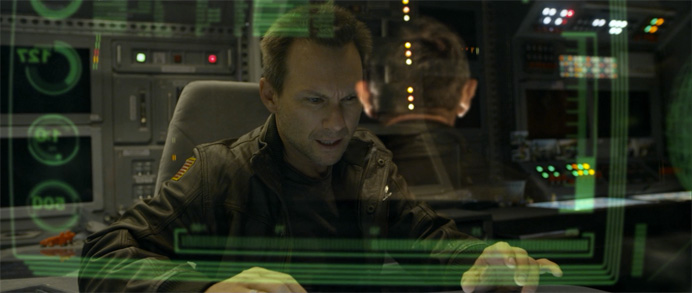
Stranded (2013)
The reason I wanted to interview you is that I landed randomly on your film Stranded on Netflix, and I watched it and really took to it. And then I looked you up, and your career is quite remarkable.
Yeah, I’ve done a few things. Yeah, Stranded is interesting.
The pacing is amazing—it sorta jumps right into everything.
That was the plan. The writer and I conceived it that way. We were doing another film called 13 Eerie before that, which was a zombie movie, and we were working with the producer in Regina [Canada], and the writer and I were trying to do Corman films like in the old days. We just wanted to do a bunch of classic horror films, or interesting films. And somebody suggested, “Why don’t you do Paranormal [Activity] in a space station, because you have this background in all this stuff.” And I didn’t want to do Paranormal. Then, both of us, funnily enough, found the film Demon Seed with Julie Christie, and both of us liked the concept of it, and I said “Why don’t we do something interesting around that kind of idea, except in a space station.” And then after we wrote it, we thought, “Oh god, we’ll never make this, because we don’t have a space station.”
Then, on the last week of the shoot on 13 Eerie in Regina, the first AD said “Oh, by the way—you know there’s a space station set in the studios in Regina?” and I thought he was just winding me up.
There was just a set laying around?
Yeah, some kid had bought it. There was a TV series that was done Vancouver, and this young rich kid had wanted to make a film, and they sold him the set for a dollar if he took it away, and he did. So they spent about six million on this set—it was a huge, huge set. So he made the film, he was a first timer, he actually had it done that way when I went over to it, so we redid the set completely so I could shoot anywhere at any time, because I only had fourteen or fifteen days to shoot this thing. So we rebuilt, we had the space station, so the producer said, “Well, if you can get an actor,” and Christian Slater came aboard, and we got it made pretty quickly.
That’s amazing.
Yeah. And I said to the writer, “So, this thing should just start. Wind you in right to the end.”
Yeah, the beginning reminds me of Gravity, but looking at the release dates, that must be a coincidence, right?
Coincidence, yeah, because I hadn’t seen that, I didn’t even know about that film when we made this.
It’s the same thing in that it starts all of a sudden.
Always a way to do something like this. Especially when you’re low-budget in this kind of arena. I think, you know, the audience obviously needs to know where it is right from the start, and it puts you right in the place. A small space crew, and that’s going to be stress right from the word go.
It’s very finite. And you use carbon monoxide poisoning, which is such an intuitive antagonist for a space movie. I don’t think I’ve ever seen that used before.
The writer I worked with and I tried to do things where we thought, ‘well, that would be such an interesting aspect of living in a moon base.’
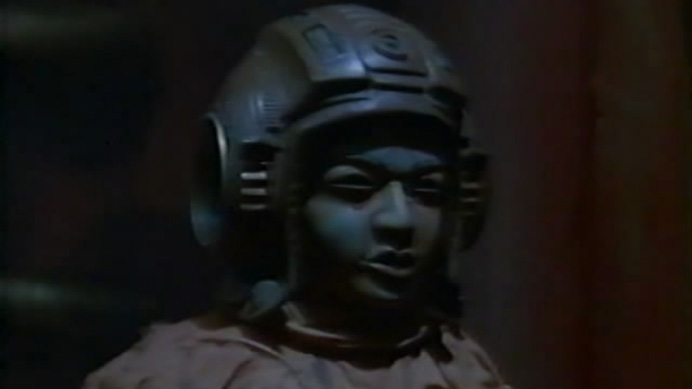
Starship (1984)
Your second feature, which I’m looking at now, it has two titles: ‘Lorca and the Outlaws’ and ‘Starship’. Which title do you prefer?
We always called it Lorca and the Outlaws when we made it, because I was trying to do—again, it was a low-budget opportunity—and we were trying to do it like a space western. So, I thought, that title was the one.
That one got into trouble. The financier bankrupted the company, didn’t pay any of us, and then bought it back for nothing and released it himself. And it’s a big shame, because I had Tony Banks from Genesis, and they were at their height at the time, and he did an amazing soundtrack for me, but this guy took it off and put in someone else [Craig Huxley] and redid the soundtrack. And it’s a shame, because we were trying to be very irreverent with it.
A clip from the film, with Tony Banks’ music reinserted.
Do you find it’s easier or harder to get something like that off the ground now, as opposed to back in ‘84?
Much harder. It’s so difficult now. The sales companies I think lost their credit lines. And it’s the same thing, everything we do, they give you a list of actors that they just print out. It’s ridiculous. We’re doing a third film in this series after Stranded, which has a really interesting concept and it has an old grandfather who dies, so they said, “Oh fine, so what we’re going to do is have a cameo with the grandfather, so we’re going to go after Daniel Day-Lewis.” And I just said, “Well, then take my name off it, because I can hear the agents laughing now, at this low-budget horror film in Regina.” And they gave me a list of actors like John Malkovich—I mean, people you just can’t get—and that’s the way they run things now, all of them. And you have to find ways around it.
There’s some really interesting production design in Lorca and the Outlaws, like the robots that have those faces that are like masks. I thought that was really great.
Yeah, they were like the Japanese Kabuki. We meant to do stuff in an original way. It’s an opportunity—when you’re doing the lower budget stuff, the pressures aren’t there. Certainly with that one, they just, you know, we just made it.
It’s a shame, because the film that we finished before this producer did what he did to it, was actually really interesting. And with a soundtrack that really suited it, it was a kind of western. I was always pushing original ideas, you know—that was always my goal for a lot of these things. I experimented with something different.
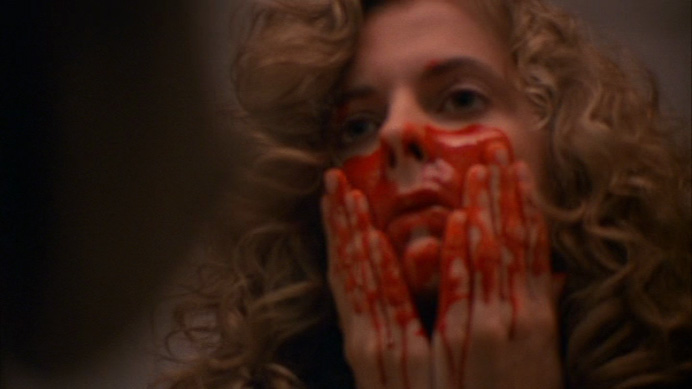
The Sender (1982)
Yeah, like The Sender is very different. That might be my favorite of yours, The Sender, and I was looking forward to watching it again in anticipation of this, but it’s hard to find now. [Ed. Note: On any streaming service—the DVD is available here.]
Yeah, it’s probably not available. This was the beginning of my career as a director, and it was a real battle with the producer and the studios who were dumping it. They were hiding it and I was fighting. In my corner, an LA Times reviewer said “This is going to do good business, this film is really great.” And when it came into Toronto, the Daily Mail actually had a go at the studio, and said, “When a film arrives in this city without the courtesy of a press reception, we know that it’s dumped by the studio. This time it’s wrong—this film is a return to Hitchcock.”
It came off the back of, first, Black Angel in particular got me a Hollywood agent, and a very good one, different from most of them. It was Harry Ufland, who looked after Ridley and Tony Scott and De Niro and people like that. And I decided that, I did Black Angel, which was kind of a visual piece. I was more interested in pursuing Tarkovsky’s kind of way of filmmaking where I was making the film for the subconscious rather the conscious. I thought I’d better do something else, so I made The Dollar Bottom, which won the Academy Award for Best Dramatic Short—it was full-on acting from 11-year-old boys, set in a boy’s school.
That won the Academy Award, so that got me The Sender, and it was with Fox, 20th Century Fox, and then right when we were well into it, almost into production, they turned around and cancelled, and Paramount Pictures picked it up in three days, and we went straight ahead.
But it’s one of these films, I found out, as I said, Paramount were completely not interested in it, they really did nothing with it at the time, which was a shame. And then it opened the Avoriaz Festival, and it’s since become like this huge thing. Apparently they asked Tarantino and it’s his favorite film of the year that it came out—it’s number one, he places it. I met him and he told me long stories about The Sender and what he did for it and things. And I just finished writing a book, which is the making of Star Wars and Alien and Black Angel, and John Rinzler, who’s a Star Wars writer—he writes all the Making Of Star Wars books, brilliant writer—he’s edited it for me, and he said, “I just got a note from Guillermo del Toro saying ‘I’m a huge fan of The Sender.’” So this film has this huge life outside of where it went in the marketplace.

Promo poster for the 1982 Avoriaz Festival.
It lodges in the back of your brain, some of those images in The Sender. I remember particularly when he’s in the hospital and the glass falls and then rises back up. It’s really remarkable.
Yeah, it was a very, very good script, and I got a really good cast of actors to do it, and it was a baptism by fire for me, with the producer and the studios and everything, and then I had the independent Lorca after that, because it was difficult to get another film because the studio side of it was down on me and everybody else was praising me. But it never opened in the UK. They said it opened in France. George Miller, the Mad Max director, was a huge fan of it, huge. So directors really, really like this film. I like that kind of genre—that’s really, to me that was such a powerful experience for me, making it, for sure.
I heard there was talk of remaking it. Is that true?
I don’t know. My manager always wanted to, and he was always pursuing that. He was trying to see if he could get someone to do it, but I need someone with a force in Paramount to go and do it, because they still own it. But it would actually be an interesting remake to do now, yes. Because the premise was amazing, I think.
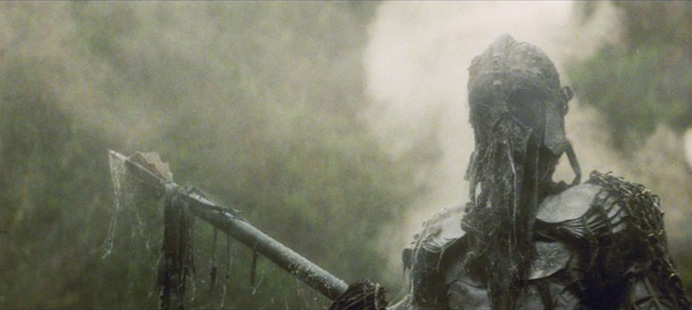
Black Angel (1980)
Yeah, I agree. Black Angel is kind of an amazing story too—that one was missing for, what, 23 years or something like that?
33 years! The negative disappeared, and I only had a print, and when I was making Nostradamus in Romania, Boss Films, Richard Edlund’s company, I was making commercials for them, I was brought on a commercials director, he went belly-up, the company went bankrupt, and they threw everything out including my print. And George Lucas had a print on the [Skywalker] Ranch and they could not find theirs in the archive. So it was pure accident, this man at Universal, I think all of the negatives that were at rank in Britain were shipped to Universal at some point, and he tracked me down.
So, yeah, that’s—it was worrying. It was at The Mill Valley Film Festival [on Oct. 13, 2013]. They restored it, Pixar and Athena, for me, and I said to the audience, “You gotta set your clocks back 33 years, which is a long time ago.” But young people really liked it. It was very slow-paced, but it was intentionally done like that. It still seemed to hold up. It was amazing to me.
It was made to accompany Empire Strikes Back, right?
Yeah, Lucas commissioned it through a government grant program in London, and he wanted a short film. Then there were programs—Japan, Australia, UK, Sweden, Europe, a lot of countries had programs where they had a twenty, twenty-five, up to thirty minute short film, and the main film. That was the program you went to see—there were no commercials then, or adverts. And 20th Century Fox had stuck a film on the front of Star Wars and George, I know, felt it alienated the audience. It was a pretty bad film.
Do you know what it was?
No. It was something about policemen. I can’t remember it. It was pretty bad. So he said, “I want a film especially commissioned to go out with Empire Strikes Back.” So then Fox were sending him scripts and stuff, and it was by accident—I was up [at Fox], Ridley was doing the sound mix on Alien and I was sitting in, just watching and listening and learning, and the head of Fox was there and asked what I was doing, and I told him and he said “give it to me right now, I have to make a decision by Friday with George on which film we’re gonna make.” So I described what I’d written, and I was back at film school at the time to do a directing course, and I couldn’t afford to make it there. And he faxed it out to George and by Friday George came back and said “That’s it, let Roger make the film, give him twenty five thousand pounds, no one’s to see it, no one’s to touch it, let him go out and do what he wants.” Which was typical George. Very helpful for filmmakers.
Is that why you’re not credited on Empire Strikes Back? On Star Wars, you’re set dresser and Jedi you’re second unit.
Second unit director, yeah, and Phantom Menace. I did all the second unit on Phantom Menace. So I just did the film that went out with Empire Strikes Back.
Between Star Wars and Alien, you really kinda crafted the future as I knew it growing up. How much autonomy do you feel you had on those sets?
It’s hard—you have to think of steering a ship through very hurricaned waters. I mean, Black Angel, I wrote and conceived and made and that was purely mine, and also The Dollar Bottom, it was a very beautiful book, a series of stories that were written by a very famous Scottish writer who wrote a film called Tunes of Glory, beautifully written, so I was able to adapt that and make that, and those films, there’s no influence. None at all. I mean, Paramount said to just go make it, and I made it, and we cut it, finished it, got it to length, and delivered it, and they, you know, they had a look at it, had no bones, they just loved it.
The Sender was a completely different story. I was hauled to LA with the editor and they wanted to completely recut the film into a back-to-front—they tried all kinds of different stuff with it and it never worked.
So it ends, really. That’s gotten more and more difficult now. It’s hard to get autonomy.
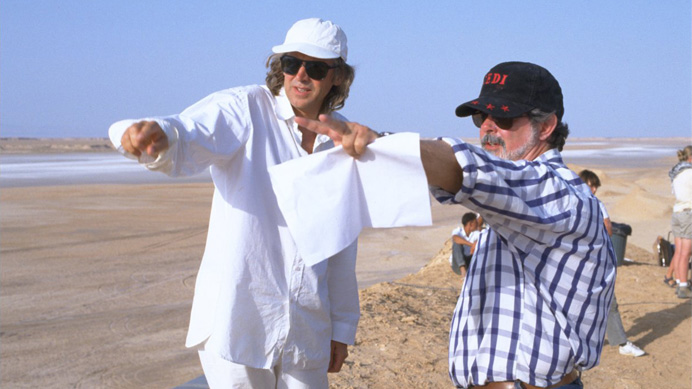
Roger Christian and George Lucas on the set of The Phantom Menace.
Did it feel different that way, coming back after twenty years between the Star Wars series? Did it feel like a different climate, doing it again in the 2000s?
The Phantom Menace? No, George ran it the same way. Exactly the same. It was like students, but with a lot more money. And there was no one on George’s back ever, telling him what to do—he was able to do what he wanted. And I felt it was very similar, it was just that the money was a lot better. There was a lot more room to do stuff. It was run by very small crews, and very similar. George is an independent filmmaker, he keeps his sets like that.
What about Battlefield Earth?
Roger Christian answers this question and many more in Part 2.
2 thoughts on “The Man Who Built R2D2 and Brought us ‘Battlefield Earth’: An Interview with Roger Christian (Part 1)”